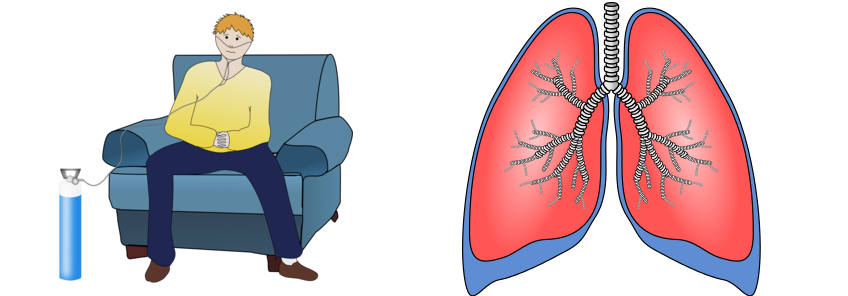
- Smoking is the most common cause of COPD. The lining of airways are inflamed and damaged by smoke.
- Exposure to air pollutants like toxic fumes, gases, smoke etc can also increase the chance of developing COPD.
- Indoor smoke exposure from firewood burning is an important cause of COPD in developing countries.
- Rarely it can be hereditary. Deficiency of an enzyme called alpha-1 antitrypsin predisposes to COPD in younger patients who are less than 40 years old.
- People who have never smoked can also develop COPD from yet unknown genetic causes.
- Passive exposure to cigarette smoking can also increase the risk of COPD.
- Breathlessness: In early stages, shortness of breath develops only on moderate exertion. Later in the disease stage patients develop shortness of breath on minimal exertion and sometimes become short of breath at rest.
- Cough: There may or may not be cough. When present, cough might be a dry cough or it could be productive of whitish color sputum.
- Others: Other nonspecific symptoms may occur like weight loss, fatigue,depression, bone loss, etc. But chest pain and blood in sputum are not commonly seen in COPD.
- Acute flare up of COPD: Symptoms of COPD (shortness of breath and cough with sputum production) can intermittently worsen during the course of the disease. These episodes are usually caused by chest infections with bacteria and viruses. Cough and shortness of breath become more severe and distressing. Blood oxygen level may drop dangerously low, which could be fatal unless patient is connected to a breathing machine.
- Spirometry (A breathing test): It is the most commonly used test to diagnose COPD. This test estimates how much air you can blow out and how fast you can blow. If the test is abnormal, it is repeated again after inhaling a medicine. If the abnormality persists, then you will be diagnosed with COPD.
- Others: Chest X-ray, CT, Blood tests to rule out other serious conditions like lung cancer, polycythemia etc.
- Pulse oximetry: It is a device that measures heart rate and amount of oxygen in the blood. Lower levels are seen in exacerbation of COPD.
- Medicines: There are various medicines used to treat COPD.
- Medications like albuterol, ipratropium, etc. are given in devices called inhalers. These help to open up the narrowed airways and decrease the swelling of airways.
- A steroid inhaler like beclomethasone along with a bronchodilator inhaler is given in more severe COPD or regular flare-ups of symptoms.
- Oral bronchodilator medicines like theophylline are also used.
- Antibiotics are used when there is chest infection.
- Medicines like morphine and codeine may be prescribed to reduce your coughing and difficulty in breathing.
- Oxygen: You will need oxygen when the disease becomes more severe. If your symptoms are very severe you may need to be admitted to hospital.
- Chest physiotherapy can be started to help you clear secretions (mucus) from your chest by coughing, deep breathing exercises and suction machines.
- Surgery: In rare cases, removal of the affected part of the lung can help reduce the symptoms.
- Make a habit of exercising regularly, which helps to improve breathing, ease symptoms, and have a better quality of life.
- Eat healthy and maintain weight. If you are overweight the chest wall is made heavy by fat. This means that you have to work harder to breathe in, to inflate the lungs and expand the chest.
COPD is a chronic condition of the lungs that causes difficulty in breathing. It is caused by long standing exposure to irritant gas or particles most commonly by cigarette smoking. In developing countries indoor smoke exposure from firewood burning also is an important risk factor.
Chronic exposure to the irritant particles or gas causes chronic inflammation of the windpipe leading to narrowing of the windpipe that makes breathing harder for you. In addition to the narrowing of the windpipe the air sacs in the lungs are also damaged.
COPD is a preventable and treatable disease. It can cause significant limitation on daily activities and it increases the risk for heart disease, lung cancer, depression and infection. It is usually detected in people over 40 years of age and is more common with increasing age. Men are affected more than women. People with COPD can have severe worsening of symptoms periodically that might require acute treatment with antibiotics including hospitalization. Most of these acute worsening are caused by viral and bacterial infection. COPD cannot be cured but the symptoms can be controlled with treatment.
Causes
Symptoms
Only one third of people who smoke cigarette develop COPD. Symptoms do not develop until significant damage has been done to the windpipe and lungs. Shortness of breath and cough are two main symptoms of COPD.
Diagnosis
COPD is diagnosed based on the presence of symptoms (dyspnea, cough), exposure to risk factors (cigarette smoke, indoor and outdoor pollution) and an abnormal breathing test.
Treatment
Quitting smoking is the best way to treat COPD especially, when it is mild and early. To ease the symptoms, there are mainly four approaches to treatment of COPD:
Prevention
Stopping smoking is the best way to prevent COPD and reduce the risk of flare ups. You need to receive vaccine against influenza virus and pneumococcus bacteria to prevent flu and other chest infections.
To prevent your disease from flaring up, you can do the following:



Send us your feedback on this article